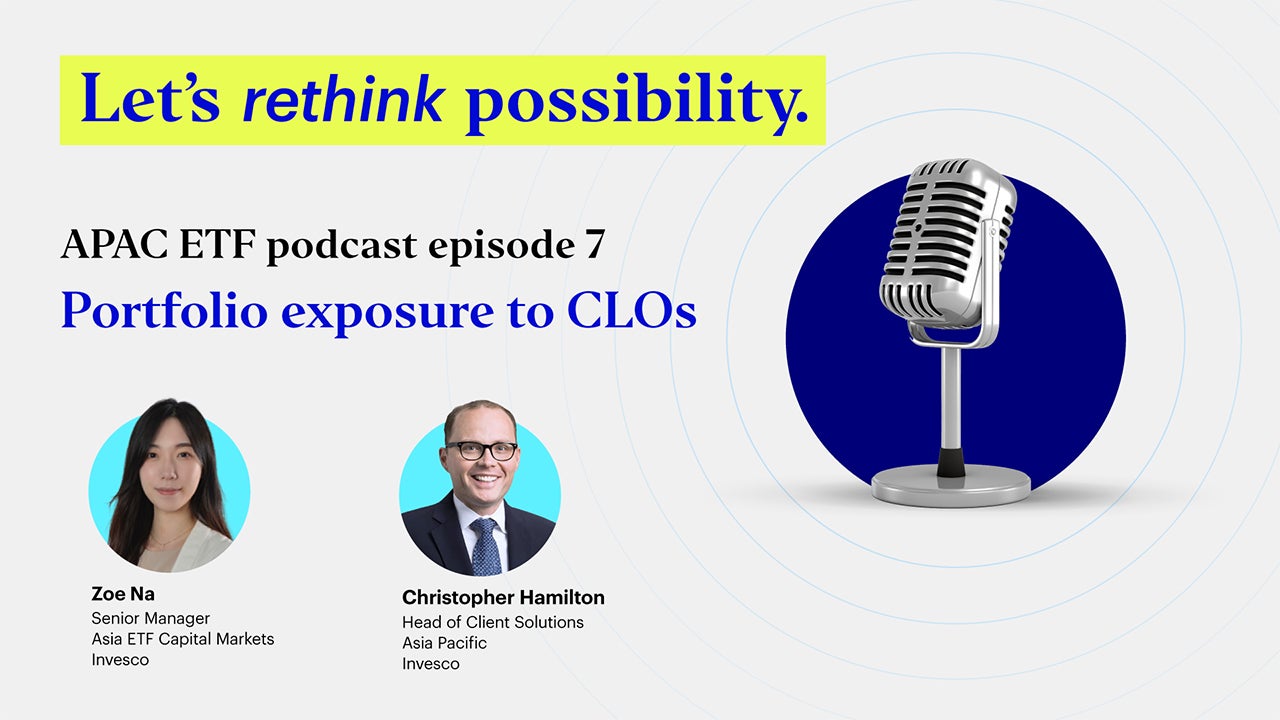ETF podcast ep 7: Portfolio exposure to CLOs

ETF podcast ep 7: Portfolio exposure to CLOs
Transcript
Hello, everyone, and welcome to our APAC ETF podcast.
I'm Zoe Na, Senior Manager of ETF Capital Markets for APAC, and today I'm joined by Chris Hamilton, the Head of APAC Investment Solutions.
Welcome, Chris.
Thank you so much, Zoe.
It's great to be on the podcast with you today.
So in the previous podcast, we spoke about what Collateralized Loan Obligations (CLOs) are and how they can be accessed simply through ETFs.
It's clear that CLOs are an interesting and differentiated asset class that investors can use to enhance yield and diversify their existing fixed income strategies.
So my first question to you, Chris is how do you view CLOs within the broader fixed income landscape?
That's a great question.
So we view CLOs , particularly high grade CLOs as an integral component of our fixed income portfolio and we really utilize it to provide ballast to our investment grade sleeve.
So we like high quality CLOs because they offer us enhanced yield.
I think a diversified source of risk, an embedded complexity premia that we could harvest for additional return to add benefit to our portfolios.
If you look at CLOs versus comparably rated investment grade corporate bonds, you'll see a spread that you could harvest from investing in CLOs of about let's say 70 to 80 basis points right now1.
1Source: S&P Global, 2024. Data reflected performance in 2024, past performance does not indicate future result.
So you could get paid that extra spread for not taking incremental credit risk.
So that's why more and more we're leveraging those high grade CLOs as really a core piece of our fixed income sleeve.
That's really helpful, thank you.
So what’s the approach of incorporating CLOs into their portfolios and also how do CLOs impact the overall shape of your clients’ portfolio?
Another great question.
So I think it’s from that perspective, you know we're really thinking about CLOs as a source of diversification and a source of income in our portfolio.
So we typically think about fixed income as a way to provide smoother return streams for our multi asset portfolios and also provide our end investors with necessary income to be able to drive their portfolio goals.
And CLOs are really an accelerant to being able to do that.
So if we're if we're building out a portfolio and let's say you know, we have 30% of our assets in investment grade corporate bonds, what we're going to do is we're going to take a slice of that allocation and then we're actually going to put it into high grade CLOs.
And like I said, we're going to use that to complement our existing investment grade bond exposure, set excess spread, but also give us diversification and embedded optionality that comes from the CLO structure.
That makes sense.
Now stepping back and looking at the current market environment, what are you seeing in the markets today and how do CLOs provide robustness and resilience in investors portfolios?
Sure, it's another excellent question.
And I think if you think about the market at a high level right now, you have a unique, I think, confluence of events where I think investors are worried about equity risk as well as interest rate risk at the same time.
So it's two, two different risks that affect your portfolio very, very differently, but have very important impacts both on traditional equities and fixed income, which typically has a duration component associated with it, which gives it a certain level of volatility when interest rates move violently like you've seen over the course of 2025.
What's unique about high grade CLOs is there isn't really an embedded duration component in the underlying instruments.
So you're just buying that high grade credit risk.
So you're mitigating yourself against volatility on the interest rate side because there's a floating rate adjustable component to those CLOs and you're also providing diversification against equity market volatility.
So we think CLOs can really triangulate those two key important risks, equity market risk and interest rate risk at the same time.
And that's why it's such a useful, helpful tool.
I think in today's unique environment.
So they kind of more than ever, this asset class should be front and center of a portfolio constructionist tool kit.
Thank you, Chris, for helping us understand the role of CLOs in today's portfolios.
So it's clear that CLOs offer a compelling combination of income diversification, benefits and also structural resilience.
And more importantly, investors don't need to be large institutional players to access this asset class.
With the right ETF solutions, even retail investors can now easily gain exposure to CLOs.
Thank you everyone for listening.
We'll catch you again soon for another episode.
In this episode, Zoe Na, Senior Manager of Asia ETF Capital Markets, and Christopher Hamilton, Head of Client Solutions, explore the strategic role of Collateralized Loan Obligations (CLOs) in client portfolios and examine how their inclusion can influence overall robustness and resilience.
0:48: How do you view CLOs within the broader fixed income landscape?
1:51: What’s the approach of incorporating CLOs into client portfolios and also how do CLOs influence the overall portfolio structure and risk profile?
3:05: What are you seeing in the markets today and how do CLOs provide robustness and resilience in investors portfolios?
Transcript
Hello, everyone, and welcome to our APAC ETF podcast.
I'm Zoe Na, Senior Manager of ETF Capital Markets for APAC, and today I'm joined by Chris Hamilton, the Head of APAC Investment Solutions.
Welcome, Chris.
Thank you so much, Zoe.
It's great to be on the podcast with you today.
So in the previous podcast, we spoke about what Collateralized Loan Obligations (CLOs) are and how they can be accessed simply through ETFs.
It's clear that CLOs are an interesting and differentiated asset class that investors can use to enhance yield and diversify their existing fixed income strategies.
So my first question to you, Chris is how do you view CLOs within the broader fixed income landscape?
That's a great question.
So we view CLOs , particularly high grade CLOs as an integral component of our fixed income portfolio and we really utilize it to provide ballast to our investment grade sleeve.
So we like high quality CLOs because they offer us enhanced yield.
I think a diversified source of risk, an embedded complexity premia that we could harvest for additional return to add benefit to our portfolios.
If you look at CLOs versus comparably rated investment grade corporate bonds, you'll see a spread that you could harvest from investing in CLOs of about let's say 70 to 80 basis points right now1.
1Source: S&P Global, 2024. Data reflected performance in 2024, past performance does not indicate future result.
So you could get paid that extra spread for not taking incremental credit risk.
So that's why more and more we're leveraging those high grade CLOs as really a core piece of our fixed income sleeve.
That's really helpful, thank you.
So what’s the approach of incorporating CLOs into their portfolios and also how do CLOs impact the overall shape of your clients’ portfolio?
Another great question.
So I think it’s from that perspective, you know we're really thinking about CLOs as a source of diversification and a source of income in our portfolio.
So we typically think about fixed income as a way to provide smoother return streams for our multi asset portfolios and also provide our end investors with necessary income to be able to drive their portfolio goals.
And CLOs are really an accelerant to being able to do that.
So if we're if we're building out a portfolio and let's say you know, we have 30% of our assets in investment grade corporate bonds, what we're going to do is we're going to take a slice of that allocation and then we're actually going to put it into high grade CLOs.
And like I said, we're going to use that to complement our existing investment grade bond exposure, set excess spread, but also give us diversification and embedded optionality that comes from the CLO structure.
That makes sense.
Now stepping back and looking at the current market environment, what are you seeing in the markets today and how do CLOs provide robustness and resilience in investors portfolios?
Sure, it's another excellent question.
And I think if you think about the market at a high level right now, you have a unique, I think, confluence of events where I think investors are worried about equity risk as well as interest rate risk at the same time.
So it's two, two different risks that affect your portfolio very, very differently, but have very important impacts both on traditional equities and fixed income, which typically has a duration component associated with it, which gives it a certain level of volatility when interest rates move violently like you've seen over the course of 2025.
What's unique about high grade CLOs is there isn't really an embedded duration component in the underlying instruments.
So you're just buying that high grade credit risk.
So you're mitigating yourself against volatility on the interest rate side because there's a floating rate adjustable component to those CLOs and you're also providing diversification against equity market volatility.
So we think CLOs can really triangulate those two key important risks, equity market risk and interest rate risk at the same time.
And that's why it's such a useful, helpful tool.
I think in today's unique environment.
So they kind of more than ever, this asset class should be front and center of a portfolio constructionist tool kit.
Thank you, Chris, for helping us understand the role of CLOs in today's portfolios.
So it's clear that CLOs offer a compelling combination of income diversification, benefits and also structural resilience.
And more importantly, investors don't need to be large institutional players to access this asset class.
With the right ETF solutions, even retail investors can now easily gain exposure to CLOs.
Thank you everyone for listening.
We'll catch you again soon for another episode.





